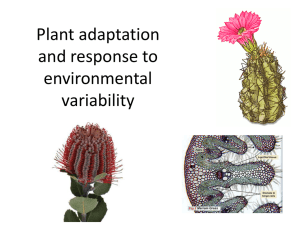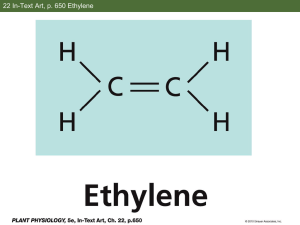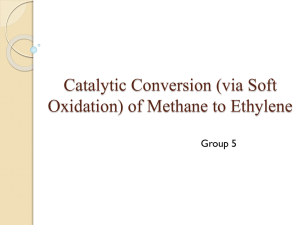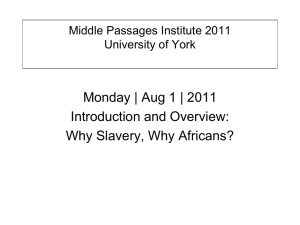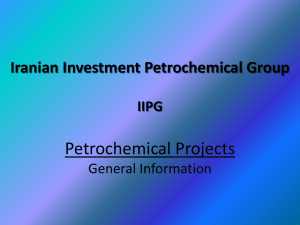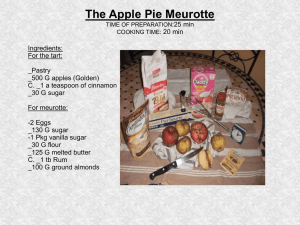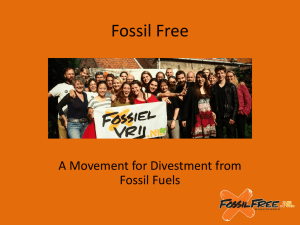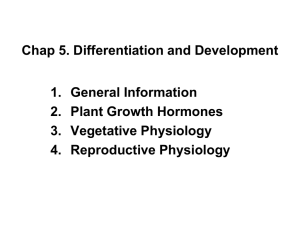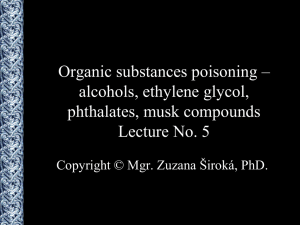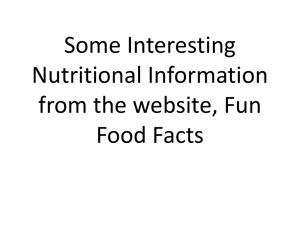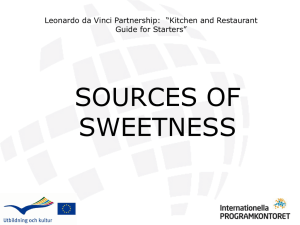The Green Premium - BioBased Economy
advertisement
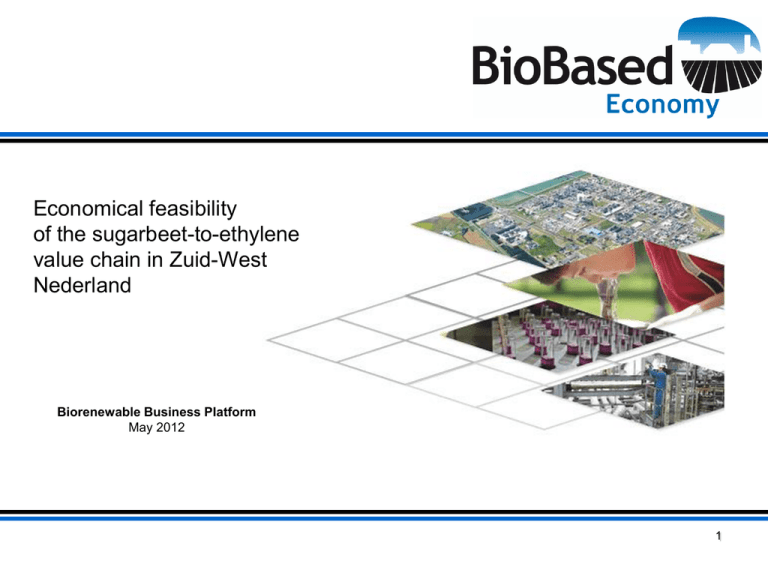
Economical feasibility of the sugarbeet-to-ethylene value chain in Zuid-West Nederland Biorenewable Business Platform May 2012 1 Importance of Ethylene • Ethylene is the largest basic building block for chemical industry and largest volume organic chemical produced (~120 million tons/yr) • Products being produced from ethylene: 2 Current Olefins Technology • Worldwide ethylene capacity in excess of 120 million MT pa • Key products include ethylene, propylene, butadiene, and benzene 3 Current Feedstock Utilization Key Olefin Starting Materials = Ethylene & Propylene 4 Green Route to Ethylene Derivatives • 95% of all chemicals and plastics are produced from non-renewable energy sources, like natural gas, crude oil and coal • Recently growing interest in alternative routes to ‘green’ chemicals • Key factors hindering introduction of chemicals and plastics from agricultural feedstock: – Cost – Product functionality limitation – Size 5 Green Route to Ethylene Derivatives 6 About Bio Renewable Business Platform The goal of the platform is to advise the Biobased Economy Program direction how to replace approximately 30 percent of the fossil fuel and feedstock needs by biobased materials in the Netherlands. The BBP develops activities within the Biobased Economy by identifying opportunities and approaching parties that can convert this opportunities into business cases. The platform provides advice and facilitates cooperation. It also passes on bottlenecks, which emerge from projects, to the government. Its members come from industry and knowledge institutions. The platform is financed by the Ministry of Economic Affairs, Agriculture and Innovation. About Roland Berger Strategy Consultants Roland Berger Strategy Consultants, founded in 1967, is one of the world's leading strategy consultancies. With 2,500 employees working in 47 offices in 35 countries worldwide, we have successful operations in all major international markets. The strategy consultancy is an independent partnership exclusively owned by about 220 Partners. About Cargill Cargill is an international producer and marketer of food, agricultural, financial and industrial products and services. Founded in 1865, the privately held company employs 139,000 people in 65 countries. Cargill helps customers succeed through collaboration and innovation, and is committed to applying its global knowledge and experience to help meet economic, environmental and social challenges wherever it does business. In fiscal year 2011, Cargill had $119.5 billion in sales and other revenues About SuikerUnie Suiker Unie develops, produces and markets sugar and sugar specialties. Her factories for the production of sugar in Dinteloord, Vierverlaten and Anklam (Northeast Germany) are among the most modern in the world. This is also true for the factories in Puttershoek and Roosendaal, which produce dry and liquid sugar specialties. The head office is located in Dinteloord. Suiker Unie forms part of Royal Cosun. This international group develops, produces and markets natural foodstuffs and food ingredients. Royal Cosun is a cooperative of approximately 10,000 sugar beet growers. The group has an annual turnover of approximately EUR 1.8 billion and has more than 4,000 employees About Dow Dow's diversified industry-leading portfolio of specialty chemical, advanced materials, agrosciences and plastics businesses delivers a broad range of technologybased products and solutions to customers in approximately 160 countries and in high growth sectors such as electronics, water, energy, coatings and agriculture. In 2011, Dow had annual sales of $60 billion and employed approximately 52,000 people worldwide. The Company's more than 5,000 products are manufactured at 197 sites in 36 countries across the globe. 7 Business Case: Sugar Beet-to-Ethylene 8 Photosynthesis 6 CO2 + 6 H2O Sugar C6-H12-O6 + 6 O2 6 CO2 + 5 H2O Starch (C6-H10-O5)n + 6 O2 6 CO2 + 5 H2O Cellulose (C6-H10-O5)n + 6 O2 Only +/- 1 % of solar energy is converted to Bio Mass energy 9 Fermentation to Ethanol C6-H12-O6 Sugar fermentation to Ethanol 2C2-H6-O + 2CO2 (C6-H10-O5)n + nH2O Starch opening to Sugar then to Ethanol (C6-H10-O5)n + nH2O Cellulose opening Sugar then to Ethanol Opening of Starch is easier than Opening of Cellulose Opening of Cellulose with Enzymes or Acid 10 Transition from fossil to renewable feed stocks for the production to ethylene will be a tremendous challenge • • • • • Feedstock availability and cost Capital requirements ‘Food vs Fuel’ issues? Green premiums? Co-mingling 11 Global Ethylene Cash Cost 12 For the european situation the import duty of 192 Euro per 1000 became is serious bottleneck. Import duty converted to $ per MT Ethylene equals 480 $ / MT. This is in the interest of Europe to become an attractive investment place and not of a company interest therefore it is evaluated against all other policy initiatives such as common agriculture policies and Mercusor free trade agreement and it will take a long period before this barrier will be removed. This study therefore focuses on utilizing feedstock from within Europe. 13 2011 Global Ethylene Cash Cost ______with European import duty_________ European energy directive 2003 14 Global Commodity Production 15 Chemistry meets Agro…. 16 From Sugar Beets to Ethylene…. 17 Maximum logistic and energy integration 18 Economic feasibility of alternative ethanol-toethylene routes relative to fossil alternative 19 Economic feasibility of alternative ethanol-toethylene routes relative to fossil alternative 20 Fossil reference business case (case 1) 21 22 Integrated ethanol-ethylene (case 5) 23 24 Green premiums over fossil in the study 20 % at ethylene level … basic view however Farma & Fine chemicals Food & Feed Chemicals & Materials Transportation fuels Seem to become higher when product application is Inside the body On the skin Distance to the skin ( packaging ) or When Brand owner identifies the brand with low carbon footprint and pays for it Power & heat or VOLUME Legislation such as bio Fuels 25 The Green Premium ( achieved for limited available volume ) Bio Polyethylene over fossil Bio PLA over fossil PET Bio Methanol over fossil Methanol Eco PET ( Teijin) over virgin PET Bio MEG 30 to 50 % 25 to 30 % > 100 % 60 % 60 % Hunt is on for bio p-xylene to bring Bio PET 26 Economic feasibility of alternative ethanol-toethylene routes relative to fossil alternative 27 Is there the capacity in the first place…? 28 Thought Provoking Questions…… • Is there a match between bulk chemicals and bio-based feed stocks? Because of mere size, replacement of fossil feed stocks by bio feed stocks poses enormous challenges 1ha sugar beets -> 12 MT sugar -> 6 MT bio-ethanol -> 3 MT bio-ethylene 1ha wheat -> 4-5 MT straw -> 1 MT bio-ethanol -> 0.5 MT bio-ethylene Dow Benelux produces 2 MMT of ethylene. To base this volume on renewable raw materials requires ~600,000 ha sugar beets or 4,000,000 ha of wheat! This is the area of The Netherlands! • • • Is a breakthrough in technology possible to reduce ethanol feedstock costs to below cash cost of fossil ethylene? Is the customer willing to pay a premium for bio-renewable products? Will the brand-owner/customer accept co-mingling of fossil and ‘green’ feed stocks, or will segregation be the norm? 29 Conclusions….. • Business case calculations indicate that bio-ethylene from sugar beet is only commercially viable with a substantial higher green premium than 20% • Only if market conditions significantly improve or process from farmers field to ethylene achieve substantial cost reductions, ethylene from sugar beets can become commercially attractive even at a premium cost over naphtha 30 Acknowledgements • Jeroen Althoff – Roland Berger Strategy Consultants • Frank van Noord – Suiker Unie • Mahir Gorur – Cargill • Kees Biesheuvel – Dow (Benelux) • Ton Runneboom– Bio Renewables Business Platform 31 Thank You It is not easy bein’ GREEN 32
